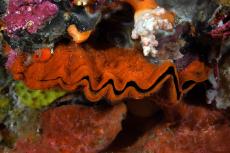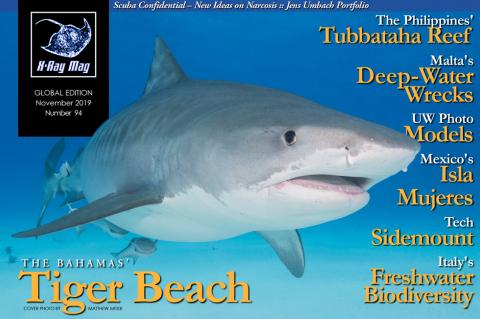Tubbataha: Pristine Diving in the Philippines
We came up over a coral ridge and yet another vista of beautiful hard and soft corals met our eyes. It was late in the day and the diminished sunlight was quickly turning the dive into a dusk adventure. After four dives in the day, we were both tired and exhilarated, and it was time to begin our ascent and head to the boat for a well-earned dinner.
Barrel sponges grow to very impressive sizes, Tubbataha, Philippines. Photo by Michael Salvarezza and Christopher P. Weaver.
Suddenly, a large section of the seafloor appeared to move. In the fading light, we could barely make out what was happening… until we got a bit closer and spotted the largest marble ray we had ever seen lifting off the bottom and flapping away into the darkness of the deep. With sandy “contrails” behind it, the smart car-sized ray lazily swam beneath us and over the ridge leading to the drop-off before disappearing completely. Reluctantly, we agreed it was time for the safety stop.
Tubbataha is a reef system lying 177km (110 miles) from the city of Puerto Princesa on the island of Palawan in the Philippines. Divers come here with the hopes of seeing large animals: whale sharks, tiger sharks, manta rays and marble rays are often encountered, along with massive schools of trevally and striped barracuda. Herds of bumphead parrotfish patrol the reefs, while tuna and silvertip sharks hunt along the walls. The parade of marine life usually does not disappoint.
What a reef should look like
But the real treasure that is Tubbataha lies in its pristine reefs and healthy marine ecosystem. For every encounter with a whale shark, there are innumerable opportunities to witness life in the sea as nature designed it. Tubbataha is, in fact, a living example of what coral reefs systems around the world should look like.
What enables this system of atolls in the Sulu Sea to thrive is a mix of isolation, weather patterns and aggressive protection from the Philippines government. What continues to threaten it, though, remains beyond their control.
The three atolls of Tubbataha (the North and South Atolls, and the Jessie Beazley Reef— an emergent coral cay) were formed millions of years ago when volcanic eruptions created small islands, which eventually collapsed back into the sea. The fringing coral reefs around these islands are the atolls we see today.
The name “Tubbataha” comes from the Samal language meaning “long reef exposed at low tide.”
Over-fishing
For generations, local fishermen were barely able to reach these reefs because of the distance from land and the capriciousness of the weather. Without motorized boats, fisherman rarely braved the frequent monsoons, typhoons and rough seas to get here. But, as inshore reefs became exhausted and better boats became available, the reefs at Tubbataha soon became a target.
As word began to spread about the productivity of these reefs, dynamite and cyanide fishing began in earnest as well as more traditional forms of fishing. The reefs were under siege.
Marine protected area
Thankfully, in 1988, President Corazon Aquino, in response to a strong campaign by scuba divers and environmentalists, and with the support of the Provincial Government of Palawan, declared Tubbataha a 97,030-hectare (970 sq km) Marine Protected Area, the first of its kind in the Philippines.
What is unique about Tubbataha is the management and conservation model that was subsequently put in place. In 1999, the Tubbataha Protected Area Management Board (TPAMB) was formed as the policy-making body for the Tubbataha reefs. It is comprised of 20 members of national and local government, academia and the private sector. Some examples of the membership include the Office of the Governor of Palawan, the Philippine Navy, the Philippine Coast Guard, the Philippine Commission on Sports and Scuba Diving, the Bureau of Fisheries and Aquatic Resources, and Palawan State University, among others. All of these members are considered important stakeholders in the future of the reefs at Tubbataha.
This body has implemented strict controls over access to the reefs. In addition, the season to visit Tubbataha is largely dictated by the monsoons and typhoons, with the general window extending from March through June. This short season gives the marine life and the reefs time to regenerate and refresh during the off season.
Divers are among the most frequent visitors and their actions are very carefully monitored. Indeed, dive guides can be heavily fined or even prohibited from working in the park if the divers they escort as much as touch the coral or harass any of the marine life. For divers, this is a very strict “no-touch” environment and good buoyancy skills are essential. We personally witnessed dive guides from a neighboring boat scolding a diver who came too close to the reefs and the ramifications can be severe: A dive guide whose divers touch the reefs or harass the marine life can be fined and prohibited from working in Tubbataha for a lengthy period of time.
The ranger station
Besides the diving, one of the highlights of any trip to Tubbataha is a visit to the ranger station located on the North Atoll. A stop here gives a glimpse into what life is like for the dedicated individuals who reside here for two months at a time protecting Tubbataha. Usually, a team of between 10 to 12 men from the Philippine Navy, the Philippine Coast Guard, the Municipality of Cagayancillo and the Tubbataha Management Office is on duty, living in a relatively spartan shelter on a small spit of sand virtually unprotected from severe weather or high seas. They are equipped with radar, motor boats and other equipment and regularly patrol the park in an attempt to thwart illegal activities. This is an essential component of the overall management plan for Tubbataha.
Our visit coincided with a visit by Angelique Songco, known locally as “Mama Ranger.” Since 2001, she has been Tubbataha’s park manager, and she works tirelessly to protect this very special place.
For visiting scuba divers, a visit to the ranger station gives grateful divers an opportunity to personally thank those who are working so hard to keep these reefs so healthy and protected.
Challenging access
Because of the distance from land, Tubbataha is only accessible by liveaboard dive vessels. While the diving is off-the-charts spectacular, this type of expedition is not for all divers. Indeed, the crossing from Puerto Princesa can take as long as 15 hours and can be rough. If there are typhoons in the region, it is not unusual to experience mountainous seas and rough diving conditions. In addition, strong currents wash over the drop-offs of the atolls and can be confusingly inconsistent. Divers should be accustomed to open water diving in conditions such as these, while being aware that Tubbataha affords very little protection from the surrounding ocean in bad weather.
Diverse reef life
Despite these caveats, diving Tubbataha is an almost ethereal experience. From the moment we peered underwater at the reefs, we were enthralled. Gardens of hard and soft corals stretched from the shallows to the deep drop-offs. Sheer walls festooned with soft corals in rainbow colors were the domain of the big animals while clouds of anthias and butterflyfish flitted amongst the coral structures.
We watched transfixed as titan triggerfish scoured their nests in broken coral plains while Napoleon wrasse poked around looking for an easy meal. We swam by whitetip reef sharks and loggerhead sea turtles resting in plain sight, and we even searched for tiny shrimp and gobies amongst the whip corals.
Diving
We traveled to Tubbataha aboard the Discovery Adventure liveaboard on an expedition organized by the Marco Vincent Dive Resort located in Puerto Galera. The daily routine was quite simple: wake to a very light breakfast, dive, enjoy a heartier breakfast, dive, lunch, dive, snack and then dive again!
For divers looking for five-star accommodations and gourmet meals, this adventure might disappoint. Nonetheless, the cabins were comfortable and clean, each with their own air conditioning units, and the food was a tasty mix of Filipino cuisine and western-style offerings. Meals were served buffet-style and this was generally a time to find divers excitedly talking about the just-completed dive and the wonders they had encountered!
All of the diving took place from zodiac-style RIBs. Teams of four to five divers would set out from the main ship to the dive sites, usually ten minutes (or less) away. On board, nitrox was available, and all the dives were preceded by a detailed dive briefing in the main cabin. We never went into the water unprepared.
Healthy coral reefs and marine life
In the end, our expedition was a resounding success. We counted nine different whale sharks over the course of the journey, along with encounters with manta rays and numerous schools of hunting trevally and barracuda. Tubbataha is a very special place in the ocean world. It is a real example of how our oceans can be protected and what healthy coral reefs really look like.
For now, the protections are in place with a strong commitment from the Philippine government. But threats remain. Some, like climate change, rising ocean temperatures and increasing acidification are beyond the ability of the rangers on-site to prevent.
We left Tubbataha under a full moon, with flashes of lightning from a distant thunderstorm behind us. The water was calm, and our crossing was quiet and serene. Tubbataha had cast a spell on us, and we were now forever in its grasp. Aware of the threats that this special place faces, but equally confident that every effort is being made to keep Tubbataha protected, we retired for the night. Tomorrow, we would begin our trek home, but our hearts would remain here, in the Sulu Sea. ■
Michael Salvarezza and Christopher P. Weaver are underwater photographers based in New York. For more information about this and other expeditions, visit: ecophotoexplorers.com.
Download the full article ⬇︎


















































